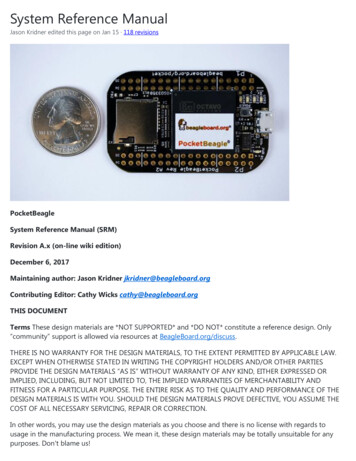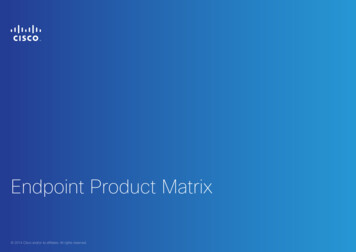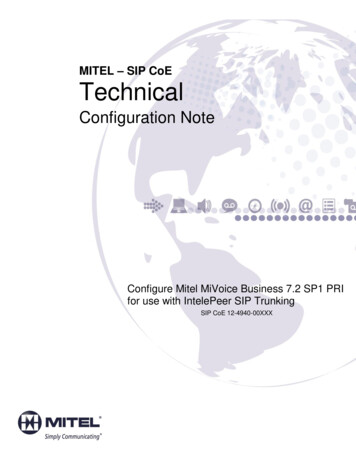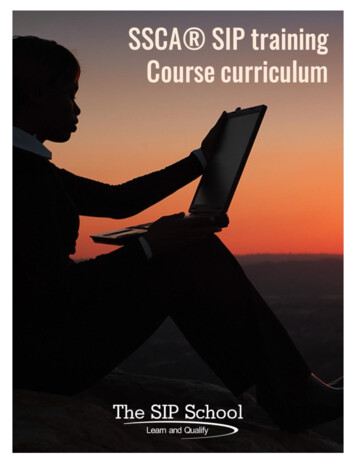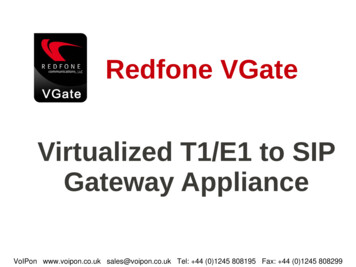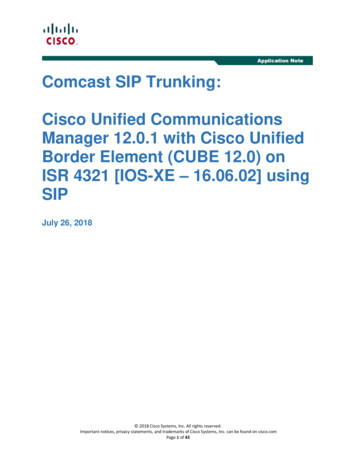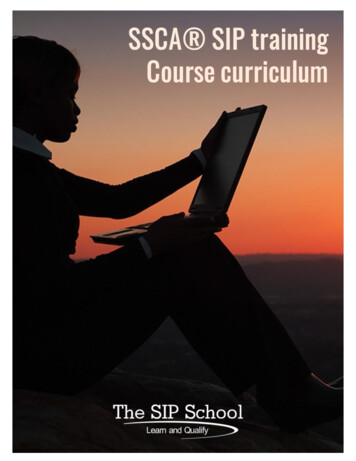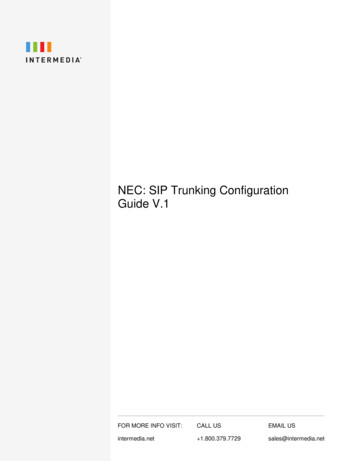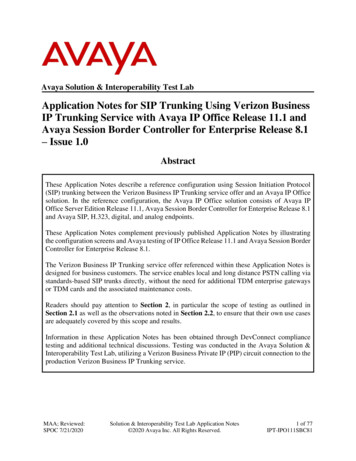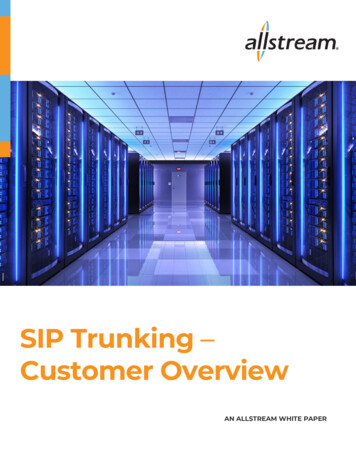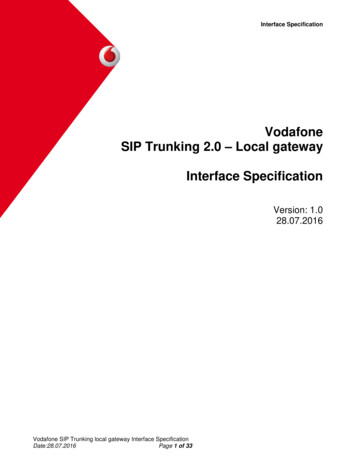
Transcription
SIP Trunking using CUCM andCisco Session Border ControllersBRKUCC-2073BRKUCC-2073 2013 Cisco and/or its affiliates. All rights reserved.Cisco Public
Housekeeping We value your feedback- don't forget to complete your onlinesession evaluations after each session & the OverallConference Evaluation Visit the World of Solutions and Meet the Engineer Visit the Cisco Store to purchase your recommended readings Please switch off your mobile phonesBRKUCC-2073 2013 Cisco and/or its affiliates. All rights reserved.Cisco Public3
Aspects of SIP Trunking Covered in this PresentationIP PBXCUCMSMEUnified CM 9.0GatewaysRich-MediaConferencingCUBEIP PSTNSAF-enabledIP NetworkUnifiedMessagingUnified CM 9.0Cisco Unified PresenceServerCTI AppsMediaResourcesCUP ClientMicroSoft/IBM clientsCUCM/SME & CUBE – Functionality for IP PSTN deploymentsCUCM – SIP Trunk FeaturesGeneral Trunking Design and Deployment GuidanceGateway Protocols reviewedCUBE – NewFeaturesBRKUCC-2073 2013 Cisco and/or its affiliates. All rights reserved.SCCPMGCPH.323CTISIP/SIMPLECSTA over SIPCisco Public4
Agenda CUCM and CUBE – Functionality for IP PSTN Deployments CUCM SIP Trunking Features‒ SIP Trunk Signalling and Basic Operation‒ SIP Trunk – Load Balancing, Availability & Redundancy‒ SIP Trunk Codec Negotiation – Audio Codec Preference Lists‒ SIP Trunk Security‒ QSIG over SIP‒ SIP Normalisation and Transparency SIP Trunk Design Considerations Gateway Integration Cisco Unified Border Element (CUBE)BRKUCC-2073 2013 Cisco and/or its affiliates. All rights reserved.Cisco Public5
CUCM and CUBE – IP PSTN ConnectivityCisco always recommends the deployment of CUBE asan SBC when connecting from CUCM to an IP PSTN . .Why ?1) Because Border Control and Phone/ SessionManagement have distinct differences in termsof their functional requirements and neitherproduct can provide all of the functionality thatthe other product has 2) The combined functionality of CUCM and IOSCUBE provides a extended feature set thatbenefits any UC deployment BRKUCC-2073 2013 Cisco and/or its affiliates. All rights reserved.IP PSTNCUBECUBECUBESessionBorderControllerUnified CMSessionManagementClusterCluster 1Cluster nQSIG PBXIP PBXIP PSTNCUBECUBECUBESessionBorderControllerUnified CMClusterCisco Public6
CUCM and CUBE – ComparisonCUCM and SME – Unique Functional CharacteristicsIP PSTNReside in a trusted Environment i.e. In the EnterpriseGUI Based – Easy to use with highly extensible provisioning, callrouting, dial plan and digit manipulation tools e.g. :Can easily configure and manage 10’s of 1000s of RoutePastterns, Number Translations & Transformations for Dial PlanNormalisation, Forced On Net Calls; Tail End Hop Off etc.Unified CMSessionManagementClusterCluster 1Cluster nCapability to provision and manage up to 80,000 devices, 2100Trunks – SCCP, H323, SIP, MGCPQSIG PBXIP PBXIP PSTNURI based Call Routing (e.g. bob@cisco.com)A call control entity – no media flow through – Combines MediaFlow Around with sophisticated Call Admission Control UBECUBESessionBorderControllerUnified CMClusterVoice, Video, Encryption and QSIG feature supportBRKUCC-2073 2013 Cisco and/or its affiliates. All rights reserved.Cisco Public7
CUCM and CUBE – ComparisonCUBE – Unique Functional CharacteristicsIP PSTN Provides a security demarcation (border) between the trustedEnterprise network and un-trusted Public network Provides hiding of internal Enterprise IP addressespresenting a single IP address for signalling and media to theoutside world Has built in tools to manage common vulnerability exploits,prevent Denial Of Service attacks and detect malformedpackets. e.g. Intrusion Prevention System, IOS Firewall. A signalling and media control point -Typically uses MediaFlow Through. Advanced Media inter-working features background noise cancellation, QOS marking, sophisticatedInterface Queuing mechanismsBRKUCC-2073 2013 Cisco and/or its affiliates. All rights d CMSessionManagementClusterCluster 1Cluster nQSIG PBXIP PBXIP PSTNCUBECUBECUBESessionBorderControllerUnified CMClusterCisco Public8
CUCM and CUBECommon Feature SetFeatureCUCMProtocol TranslationSIPCUBEIP PSTNSIPCUBECUBEH323H323MGCPScripting for SIP Normalisation andTransparencyVeryPowerfulGood nestModification of SIP MessagesYesYesModification of SDP ContentYesYesStorage and re-use of valuesYesRegExpUnified CMSessionManagementClusterCluster 1CUBEYesYesVoice TranscodingYesYesBRKUCC-2073Cluster n 2013 Cisco and/or its affiliates. All rights reserved.QSIG PBXIP PBXIP PSTNDTMF translationRFC 2833 NTE, KPML, Unsolicited Notify,H245 Signal, H245 Alpha, Cisco rControllerUnified CMClusterCisco Public9
CUCM and CUBECommon Feature SetFeatureCUCMMedia Flow Around (MFA)YesCUBEIP PSTNYesCUBECUBEMedia Flow Through (MFT)NoYesBasic Call CountingYesYesPer Call Bandwidth Aware CallCountingEnhancedLocations CACYes fwwilltextsRSVPYesYes(MFT only)User InterfaceGUIGUI & CLIBasic TasksGUIGUIComplex TasksGUICLIManaging 1000s of entriesVery GoodFairCall Admission ControlBRKUCC-2073 2013 Cisco and/or its affiliates. All rights reserved.CUBESessionBorderControllerUnified CMSessionManagementClusterCluster 1Cluster nQSIG PBXIP PBXIP PSTNCUBECUBECUBESessionBorderControllerUnified CMClusterCisco Public10
CUCM and CUBECommon Feature SetFeatureCUCMCUBEIP PSTNPath ReplacementQSIG basedSIP basedCUBECUBESecure RTP & TLSYesYesConnections only from Trusted IPAddressesYesYesOPTIONS PingSend and ReceiveYesYesOff Box stateful redundancy for SIPsignallingPlannedDigit Manipulation for Dial PlanNormalisation. Forced On Net, Tail EndHop OffVery powerfulCan easily manage very large dialplansYesNoExternal Call Control /Policy interfaceYes CURRIYes UCServices APIBRKUCC-2073CUBESessionBorderControllerUnified CMSessionManagementClusterCluster 1Cluster nQSIG PBXIP PBXYesIP PSTNGoodCUBE 2013 Cisco and/or its affiliates. All rights reserved.CUBECUBESessionBorderControllerUnified CMClusterCisco Public11
CUCM and CUBEExtended Feature SetFeatureCUCM IP PSTNCUBEVoice fied CMSessionManagementClusterVideo Trans-ratingPhone RegistrationAdvanced Media Interworking (NoiseCancellation etc)Cluster 1Cluster nIP PBXIP PSTNTDM Voice Interfaces (Analogue, Q931and QSIG)WAN InterfacesCUBEQSIG Features e.g. Call back on BusyQSIG PBXCUBECUBESessionBorderControllerUnified CMClusterVoice XMLBRKUCC-2073 2013 Cisco and/or its affiliates. All rights reserved.Cisco Public12
CUCM and CUBEExtended Feature SetFeatureCUCM CUBEIP PSTNRegistration and management of Internetbased Phones with ed CMSessionManagementClusterSurvivable Remote Site Telephony(SRST)Gatekeeper FunctionalityCluster 1Advanced IP Routing SuiteCluster nQSIG PBXIP PBXIP PSTNFirewallIntrusion Prevention SystemCUBEService Advertisement Framework (SAF)CUBECUBESessionBorderControllerUnified CMClusterSIP Pre-conditions for RSVP based CACBRKUCC-2073 2013 Cisco and/or its affiliates. All rights reserved.Cisco Public13
CUCM SIP TrunkingAgenda‒Overview of CUCM SIP Trunk Features‒SIP Trunk Signalling and Basic Operation‒SIP Trunk – Load Balancing, Availability & Redundancy‒SIP Trunk Codec Support – Audio Codec Preference Lists‒SIP Trunk Security‒QSIG Over SIP‒SIP Normalisation and TransparencyBRKUCC-2073 2013 Cisco and/or its affiliates. All rights reserved.Cisco Public14
CUCM SIP Trunking Features - OverviewCUCM 8.5 SIP Trunk Features :‒ Run on All Active Unified CM Nodes‒ Up to 16 Destination Addresses‒ SIP OPTIONS Ping‒ SIP Early Offer for Voice & Video (Insert MTP if needed)‒ QSIG over SIP‒ SIP Normalisation and TransparencyCUCM 8.6 SIP Trunk Feature :‒ REFER TransparencyCUCM 9.0 Features :‒ Audio Codec Preference Lists‒ SIP Trunk “Accept Received Codec Preference”BRKUCC-2073 2013 Cisco and/or its affiliates. All rights reserved.Cisco Public15
CUCM SIP Trunking‒Overview of CUCM SIP Trunk Features‒SIP Trunk Signalling and Basic Operation‒SIP Trunk – Load Balancing, Availability & Redundancy‒SIP Trunk Codec Support – Audio Codec Preference Lists‒SIP Trunk Security‒QSIG Over SIP‒SIP Normalisation and TransparencyBRKUCC-2073 2013 Cisco and/or its affiliates. All rights reserved.Cisco Public16
SIP Trunk Signalling and Basic OperationSIP Messaging – Delayed and Early OfferSIP Early OfferInformation about the calling device’s media characteristics are sent with its initial SIP INVITEmessage – The media characteristics are contained in the Session Description Protocol (SDP) bodysent with the SIP INVITE – The “Offer” in the SDP body will contain the IP Address, UDP Portnumber, list of codecs etc. supported by the calling deviceThe called device selects which of the offered codecs it wishes to use for the call and returns its“Answer” in the SDP body of a SIP response – The Answer also contains the IP address and UDPport number etc of the called deviceOnce the Answer has been received and acknowledged two way media can be establishedEarly Offer is widely used ( particularly by Service Providers . )INVITE w/ SDP (Offer)INVITE w/ SDP (Offer)100 Trying100 Trying180 Ringing180 Ringing200 OK w/ SDP (Answer)One WayMedia200 OK w/ SDP (Answer)Two Way MediaACKBRKUCC-2073ACK 2013 Cisco and/or its affiliates. All rights reserved.Cisco Public17
SIP Trunk Signalling and Basic OperationSIP Messaging – Delayed and Early OfferSIP Delayed OfferNo information about the calling device’s media characteristics are sent in the initial SIP INVITEInstead the first set of media characteristics for the call are sent by the called device in the SessionDescription Protocol (SDP) body of the next reliable message (200 OK) – The called device’s “Offer” willcontain its IP Address, UDP Port number, list of codecs etc.The calling device selects which of the offered codecs it wishes to use for the call and returns its“Answer” in the SDP body of a reliable SIP response (ACK) – The Answer also contains the IP addressand UDP port number etc of the calling deviceDelayed Offer is a mandatory part of the SIP standard – Most Service Providers prefer Early OfferOrdinarily, the Offer or Answer cannot be sent with 100 Trying or 180 Ringing as 1XX messages areunreliable (unacknowledged) This can be resolved using PRACK . discussed later .BRKUCC-2073INVITEINVITE100 Trying100 Trying180 Ringing180 Ringing200 OK w/ SDP (Offer)200 OK w/ SDP (Offer)ACK w/ SDP (Answer)ACK w/ SDP (Answer)Two Way Media 2013 Cisco and/or its affiliates. All rights reserved.Cisco Public18
SIP Trunk Signalling and Basic OperationSIP Messaging – Delayed and Early OfferInbound SIP Delayed Offer to Outbound SIP Early OfferSo what happens when Unified CM receives an inbound call on a Delayed Offer Trunk andneeds to onward route the call over a Early Offer Trunk ?It does not have the calling device’s media characteristics and it needs to send an Offer inSDP with the outbound INVITE Solution – Insert a Media Termination Point (MTP) and use its media characteristics tocreate the Offer in SDP with the outbound INVITESIP Delayed OfferBRKUCC-2073SIP Early OfferINVITEINVITE w/ SDP (MTP)100 Trying100 Trying180 Ringing180 Ringing200 OK w/ SDP (Offer)200 OK w/ SDP (Answer)ACK w/ SDP (Answer)ACKTwo Way Media 2013 Cisco and/or its affiliates. All rights reserved.MTPCisco Public19
SIP Trunk Signalling and Basic OperationSIP Messaging – Enabling SIP Early Offer – Method 1SIP Trunk “MTP Required” CheckboxSIP LineSIP Trunk with Early OfferMTPSCCP LineMTPSIP TrunkMTPH323 TrunkMGCP TrunkSIP Trunk with Early OfferSIP Trunk with Early OfferSIP Trunk with Early OfferMTPSIP Trunk with Early OfferMTPUsing the “MTP Required” option :SIP Early Offer Trunks use the Trunk’s Media Termination Point (MTP) resources, inserting an MTP into themedia path for every outbound call – sending the MTP’s IP Address, UDP port number and codec in the SDPbody of the initial SIP INVITE instead of those of the endpoint.Disadvantages : MTPs support a single Audio codec only e.g. G711 or G729. The passthru codec is notsupported excluding the use of SRTP and video calls. Since the Trunk’s MTPs are used rather than the callingdevice’s MTPs - The media path is forced to follow the signalling path.BRKUCC-2073 2013 Cisco and/or its affiliates. All rights reserved.Cisco Public20
SIP Trunk Signalling and Basic OperationSIP Messaging – Enabling SIP Early Offer – Method 2SIP LineSIP Trunk with Early OfferSCCP LineSIP Trunk with Early OfferSCCP LineSIP Trunk with Early OfferSIP TrunkSIP Trunk with Early OfferSIP TrunkSIP Trunk with Early OfferH323 TrunkSIP Trunk with Early OfferH323 TrunkSIP Trunk with Early OfferMGCP TrunkSIP Trunk with Early OfferCisco SIP PhonesNewer SCCP PhonesMTPOlder SCCP PhonesSIP Early OfferMTPNew SIP Profile checkbox “Early Offer support forvoice and video calls (insert MTP if needed)”For Calls from trunks and devices that can providetheir IP Address, UDP port number and supportedcodecs - This information is sent in the SDP body ofthe initial SIP Invite on the outbound Early OfferTrunk. No MTP is used for the Early OfferSIP Delayed OfferMTPH323 Slow StartH323 Fast StartMGCP GatewayBRKUCC-2073For Calls from trunks and devices that cannotprovide Early Offer information – use the callingdevice’s MTP resources (first) or the outboundtrunk’s MTPs (second) to create a SIP Offer for anunencrypted voice call. (SRTP and video cansubsequently be initiated by the called device) 2013 Cisco and/or its affiliates. All rights reserved.Cisco Public21
SIP Trunk Signalling and Basic OperationSIP Messaging – Enabling SIP Early Offer – Method 2SIP LineSIP Trunk with Early OfferSIP TrunkSIP Trunk with Early OfferH323 TrunkSIP Trunk with Early OfferH323 TrunkSIP Trunk with Early OfferMGCP TrunkSIP Trunk with Early OfferMTPCisco SIP PhonesSIP Delayed OfferSCCP LineSIP Trunk with Early OfferMTPH323 Slow StartNewer SCCP PhonesMTPSCCP LineSIP Trunk with Early OfferOlder SCCP PhonesH323 Fast StartSIP TrunkSIP Early OfferSIP Trunk with Early OfferMGCP GatewayBenefits of “Early Offer support for voice and video calls (insert MTP if needed)” Reduced MTP usage Single voice codec MTP limitation removed (by using the pass through codec) Voice codecs sent in SIP Offer based on calling device capabilities & region settings Video Calls supported Encryption supported Use of the Calling device’s MTP rather than Trunk’s MTP- Media does not have to follow the signalling pathBRKUCC-2073 2013 Cisco and/or its affiliates. All rights reserved.Cisco Public22
SIP Trunk – CUBE DO to EOSIP Messaging – Enabling SIP Early Offer – CUBE Configuration of codecs is required on CUBE to send in the outgoing Early Offer SIP INVITEwhen a Delayed Offer INVITE is received on the incoming leg Early Offer on outgoing leg can be configured either globally or per dial-peer; dial-peerconfiguration overrides Codec list to populate in outgoing Early Offer is configured on dial-peer Important when CUCM cannot use Early OfferDial-peer ConfigurationGlobal Configurationvoice class codec 1codec preference 1 g711ulawcodec preference 2 g729avoice service voipsipearly-offer forceddial-peer voice 4 voipdestination-pattern 321.voice-class codec 1voice-class sip early-offer forcedsession target ipv4:9.6.3.22SIP Trunk from CUCMSIP Delayed Offer without SDPBRKUCC-2073SIP Trunk to Service ProviderCUBE 2013 Cisco and/or its affiliates. All rights reserved.IP PSTNSIP Early Offer SDPwith IP Address of CUBECisco Public23
SIP Trunk Signalling and Operation – PRACK 1SIP Early Media – Using Provisional Acknowledgement (PRACK)SIP defines two types of responses: Final and Provisional.Final responses convey the result of the processed request, and are sent reliably (i.e. they areacknowledged).Provisional responses provide information on the progress of the request, but are not sent reliably – sothe sender of a provisional response does know that it has been received.To send an Offer or Answer with a provisional 1XX response – these responses must be sent reliably .PRACK – Provisional Reliable Acknowledgement is used to provide 1XX responses with reliability.Early Offer Early MediaDiagram : Early Offer with Early MediaINVITE w/ SDP Supported:100relINVITE w/ SDP Supported:100rel100 Trying100 Trying183 Progress w/ SDP Require:100rel183 Progress w/ SDP Require:100relTwo Way MediaPRACK200 OK (PRACK)BRKUCC-2073 2013 Cisco and/or its affiliates. All rights reserved.PRACK200 OK (PRACK)Cisco Public24
SIP Trunk Signalling and Operation – PRACK 2SIP Early Media – Using Provisional Acknowledgement (PRACK)Like final responses, by using PRACK - 1XX messages will be periodically re-sent until their receipt isacknowledged by the receiver by sending a PRACK, which is also acknowledged by the 1XX sender.Using PRACK can reduce the number of SIP messages that need to be sent before two way media canbe establishedPRACK is useful in situations where long Round Trip Times between SIP devices can cause a delay tomedia cut through or media clippingPRACK can be enabled on the SIP Trunk Profile by setting “SIPRel1XX Options” to enabledDiagram : Delayed Offer with Early MediaINVITE Supported:100relINVITE Supported:100rel100 Trying100 Trying183 Progress w/ SDP Require:100rel183 Progress w/ SDP Require:100relPRACK w/ SDPPRACK w/ SDP200 OK (PRACK)BRKUCC-2073Two Way Media 2013 Cisco and/or its affiliates. All rights reserved.200 OK (PRACK)Cisco Public25
SIP Trunk Signalling and Basic OperationSIP Messaging – Hold/Resume SignallingUserPressesHoldTwo Way MediaINVITE w/ SDP(a sendonly)INVITE w/ SDP(a inactive)200 OK w/ SDP(a inactive)200 OK w/ SDP(a recvonly)ACKACKUserPressesResumeINVITE w/ SDP(a sendrecv)INVITE w/o SDP200 OK w/ SDP(a sendrecv)ACK200 OK w/ SDP(a sendrecv)ACK w/SDP(a sendrecv) To Hold and Resume a call CUCM sends : a inactive in SDP to stop media Delayed Offer to start MoH orresume media The remote entity must respond with itsfull codec list and a sendrecv when itreceives Delayed Offer for MoH or toresume held callTwo Way MediaThe SDP media attributes are interpreted from the senders perspective :sendrecv - Used to establish a 2-way media streamrecvonly - Endpoint will only receive media (listen) and not send mediasendonly - Endpointwill only send and not 2013receivemedia- Endpoint will neither26Cisco sendPublic nor receive mediaBRKUCC-2073Cisco and/orits affiliates.InactiveAll rights reserved.
SIP Trunk Signalling and Basic OperationSIP Messaging – TransferTo Transfer a call - Unified CM :Two Way MediaUserPressesTransferUserDials 2ndNumberInitiates HOLDHOLD CompleteUserPressesTransferAgainHOLD CompleteInitiate 2nd CallCall CompleteCall Complete200 OKBYEBYETransferor Connects to Transfer Target Updates the connectedname/number for each call Updates the SDP information foreach call leg Disconnects the TransferorMedia flows directly between theconnected partiesINVITE/200/ACK(with SDP)INVITE/200/ACK(with SDP)Two Way MediaTransfereeBRKUCC-2073Places the active call on hold andplays MoHInitiate HOLDInitiate 2nd CallREFER 2013 Cisco and/or its affiliates. All rights reserved.TransferTargetBy default Unified CM does NOT forwardREFERs – but sends an INVITE insteadand maintains call signalling controlWith CUCM 8.6 – REFER TransparencyLUA script can be enabled on SIP Trunksallowingcall control to be relinquished 27Cisco Public
CUCM SIP Trunking‒Overview of CUCM SIP Trunk Features‒SIP Trunk Signalling and Basic Operation‒SIP Trunk – Load Balancing, Availability & Redundancy‒SIP Trunk Codec Support – Audio Codec Preference Lists‒SIP Trunk Security‒QSIG Over SIP‒SIP Normalisation and TransparencyBRKUCC-2073 2013 Cisco and/or its affiliates. All rights reserved.Cisco Public28
Unified CM SIP TrunksUC 8.5FeaturesLoad Balancing, High Availability & Redundancy – IntroductionHA Features affecting Calls originating from aCUCM clusterHA Features for SIPTrunk destinationsCalls over single SIP TrunksCalls over multiple SIP TrunksCall Manager GroupsCall Manager GroupsUp to 16 Destination IPAddressesRoute Lists and Route GroupsDNS SRVRun on All NodesRun on All NodesSIP OPTIONS PingRoute LocalRoute LocalBRKUCC-2073 2013 Cisco and/or its affiliates. All rights reserved.Cisco Public29
SIP Trunk Load Balancing, Availability & RedundancyRedundancy and Load Balancing – Multiple Trunk RoutesRoutePatternFirstChoice Create redundant routes for the samedestinationRouteListRouteGroupFirstChoice‒A distribution algorithm in Route Groupdetermines which trunk will be used nextThirdChoiceCUBEBRKUCC-2073 Trunks are placed in Route GroupsRouteGroupSecondChoiceIP WAN‒A trunk denotes a unique routeSecondChoice(IP) PSTN Route Groups are placed in priority orderinto a Route List A Route Pattern contains the Route List 2013 Cisco and/or its affiliates. All rights reserved.Cisco Public30
SIP Trunk Load Balancing, Availability & RedundancyCall Routing Pre CUCM 8.5 – Source and Destination IP Address LimitsSIP Trunk 1SIP Trunk ACUBESIP Trunk 2SIP Trunk BCUBERoute ListRoute ListSIP TrunksUp to 3 source IP addresses (Call Manager Group)1 destination IP address or a single DNS SRV RecordRoute ListsThe Route List is active only on the primary node on its Call Manager GroupThe Route List’s primary node should not be co-resident on a node used byassociated outbound Trunks as this can limit the choice of server for outboundTrunk callsBRKUCC-2073 2013 Cisco and/or its affiliates. All rights reserved.Cisco Public31
Pre CUCM 8.5 – Trunk Call Routing – “Route Local” (1)The Route Local feature – Single Outbound TrunkRoute Local has an influence on which server is used to initiate outbound callsSIP ICTSIP ICTCall DirectionCall DirectionCall Manager Servers inthe Trunk’s CallManager GroupTrunk’sDestinationAddressCall Manager Servers inthe Trunk’s CallManager GroupTrunk’sDestinationAddressSingle ICT – No Route Lists and Route GroupsPhone is registered to same node as the TrunkSingle ICT – No Route Lists and Route GroupsPhone is NOT registered to same node as TrunkRoute Local BehaviourRoute Local BehaviourIf the calling device is registered to a CUCM serverthat is also a server in the selected outbound Trunk’sCall Manager Group .If the calling device is NOT registered to a CUCMserver that is a server in the selected outboundTrunk’s Call Manager Group .Then use this server to initiate the outbound TrunkRandomly distribute calls across the servers in thecallTrunk’s Call ManagerCisco PublicGroup for outbound Trunk calls 32BRKUCC-2073 2013 Cisco and/or its affiliates. All rights reserved.
Pre CUCM 8.5 Trunk Call Routing – “Route Local” (2a)The Route Local feature – Multiple Outbound Trunks with Route List and Route GroupsRoute Local has an influence on which server is used to initiate outbound callsRoute ListTrunk CMGs use RL CMSIP Trunk 1Route ListOne CM in each Trunk CMGSIP Trunk 1SIP Trunk 2SIP Trunk 2SIP Trunk 3SIP Trunk 3SIP Trunk 4SIP Trunk 4Route Local affects the choice of server usedto originate outbound callsCall distribution to Trunk DestinationAddresses controlled by Route GroupRoute Local does not affectthe choice of server used tooriginate outbound callsCall distribution to Trunk DestinationAddresses controlled by Route GroupRoute Local with Route ListsWhen multiple Trunks are used with Route Lists and Route Groups – The Route List is considered to be the“calling device”. When a call arrives at the Route List it will select an outbound Trunk from its Route Groups(The Route List is active only on the primary UCM in the RL’s Call Manager Group)If the calling device (Route List) is registered to a CUCM server that is also a server in the selected outboundTrunk’s Call Manager Group - Then use this server to initiate the outbound Trunk callIf the calling device (Route List) is not registered to a CUCM server that is a server in the selected outboundTrunk’s Call Manager Group - Then randomly distribute calls across the servers in the Trunk’s Call ManagerCisco Public 2013 Cisco and/or its affiliates. All rights reserved.Group to BRKUCC-2073initiate outbound Trunk calls33
Pre CUCM 8.5 – Trunk Call Routing – “Route Local” (2b)The Route Local feature – Multiple Outbound Trunks with Route List and Route GroupsRoute Local has an influence on which server is used to initiate outbound callsRoute ListRoute ListOne CM in each Trunk CMGSIP ICTsSIP Trunk 1Call DirectionSIP Trunk 2SIP Trunk 3SIP Trunk 4Call Manager Servers inTrunk 1 and Trunk 2Call Manager GroupsTrunk 1 & Trunk 2DestinationAddressesRoute Local does not affectthe choice of server used tooriginate outbound callsCall distribution to Trunk DestinationAddresses controlled by Route GroupRoute Local with Route Lists – Recommendation do not co-locate RL and TrunksWhen multiple Trunks are used with Route Lists and Route Groups – The Route List is considered tobe the “calling device”. When a call arrives at the Route List it will select an outbound Trunk from itsRoute GroupsIf the calling device (Route List) is not registered to a CUCM server that is a server in the selectedoutbound Trunk’s Call Manager Group – Then randomly distribute calls across the servers in theTrunk’s CallManager Group to initiateoutbound Trunk callsCisco PublicBRKUCC-20732013 Cisco and/or its affiliates. All rights reserved.34
SIP Trunk Load Balancing, Availability & RedundancyCUCM 8.5 Call Routing – Source & Destination IP Address EnhancementsICT TrunkTrunk ACUBETrunk BCUBERoute ListSIP TrunksUp to 16 source addresses – by enabling “Run on all Active Unified CM Nodes”Up to 3 source addresses using standard CM GroupsUp to 16 configured destination IP addresses or a single DNS SRV RecordRandom distribution of calls over configured destination IP addressesRoute ListsEnable “Run on all Active Unified Nodes” to activate Route List on all Unified CM nodes“Run on All Nodes” in conjunction with the “Route Local” rule reduces intra-cluster trafficIn effect, the node that the inbound call arrives on is the node that is used to initiate the outboundCisco PublicBRKUCC-2073 2013 Cisco and/or its affiliates. All rights reserved.call35
SIP Trunk Load Balancing, Availability & RedundancyThe Route Local Rule and “Run on all nodes” Option for Trunks and RLsICT TrunkSIP TrunkCUBECUBEICT TrunkTrunk ACUBETrunk BCUBERoute ListFor single TrunksThe Route Local rule operates inconjunction with the “Run on all Nodes”feature enabled on the Trunk - Such thatoutbound Trunk calls originate from thesame node that the inbound call arrives onMultiple Trunks using Route ListsThe Route Local rule operates inconjunction with the “Run on all Unified CMNodes” feature enabled on the Route Listand Trunks - Such that outbound Trunkcalls originate from the same node that theinbound call arrives onBenefit – Calls more evenly distributed across all nodes within a clusterBRKUCC-2073 2013 Cisco and/or its affiliates. All rights reserved.Cisco Public36
SIP Trunk Load Balancing, Availability & RedundancyCUCM 8.5 SIP OPTIONS Ping – Improved Failover .SIP ICT TrunkSIP TrunkCUBECUBEOPTIONS Ping is activated on a per SIP Trunk basisEach node running the SIP Trunk daemon in the originating cluster uses OPTIONS Ping todetermine the availability of each defined destination IP address- CUCM will not attempt to establish a call to an unavailable remote peer- SIP Trunk - “In Service” whilst one remote peer is reachable- SIP Trunk - “Out Of Service” state when all remote peers are unreachable- CUCM 8.5 – Dynamic reach-ability detection- Pre CUCM 8.5 - Per call time outBRKUCC-2073 2013 Cisco and/or its affiliates. All rights reserved.Cisco Public37
SIP Trunk Load Balancing, Availability & RedundancyCUCM 8.5 – Benefits of New Call Routing FeaturesICT TrunkICT TrunkTrunk ATrunk ACUBECUBETrunk BTrunk BCUBECUBERoute ListRun on All Active Unified CM Nodes, Up to 16 Destination Addresses- Fewer Trunks, fewer Route Lists and Route Groups required- Calls evenly distributed across all destination addresses- Outbound calls originate from the node that the call arrived onOPTIONS Ping- Dynamic reachability detection- Calls only sent to those SIP Trunk destinations known to be aliveBRKUCC-2073 2013 Cisco and/or its affiliates. All rights reserved.Cisco Public38
SIP Trunk Load Balancing, Availability & RedundancyRedundancy and Load Balancing – Using DNSsip. tcp.cluster1.cisco.comsip. cluster2.cisco.comRequires HA DNS ServerOPTIONS Ping .10.2DNS ServerPriority & WeightingSupports 16 addressesSIP cm1.cluster1.cisco.com Dst:cucmA.cluster2.cisco.comCUCM2Cluster 186453001Calls 87522001BRKUCC-2073Route Pattern: 8752XXXX SIPTrunkDst: DNS SRV cluster2.cisco.comRoute Pattern: 8645XXXX SIPTrunkDst: DNS SRV cluster1.cisco.com 2013 Cisco and/orits affiliates.rightsreserved.DNSA LookAllUpnotshownCisco PublicCUCMBCluster 28752200139
CUCM 8.5 SIP Trunking‒Overview of CUCM SIP Trunk Features‒SIP Trunk Signalling and Basic Operation‒SIP Trunk – Load Balancing, Availability & Redundancy‒SIP Trunk Codec Support – Audio Codec Preference Lists‒SIP Trunk Security‒QSIG Over SIP‒SIP Normalisation and TransparencyBRKUCC-2073 2013 Cisco and/or its affiliates. All rights reserved.Cisco Public40
Unified CM SIP Trunks – Pre UC 9.0Audio CodecDeterminationInter Region Configuration(Max Audio Bit Rate 64kbps)Originating Side Offer(G.711, G.723, G.729)Terminating Side Offer(G.711, G.729, G.722)Selection Policies Codec selection determined by anintersection of codecs in originatingand destinati
CUCM SIP Trunking Features - Overview CUCM 8.5 SIP Trunk Features : ‒ Run on All Active Unified CM Nodes ‒ Up to 16 Destination Addresses ‒ SIP OPTIONS Ping ‒ SIP Early Offer for Voice & Video (Insert MTP if needed) ‒ QSIG over SIP ‒ SIP Normalisation and Transparency CUCM 8.6 SIP Trunk Feature : ‒ REFER Transparency
